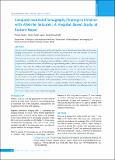Please use this identifier to cite or link to this item:
https://hdl.handle.net/20.500.14356/1624Full metadata record
| DC Field | Value | Language |
|---|---|---|
| dc.contributor.author | Poudel, Prakash | - |
| dc.contributor.author | Gupta, Mukesh Kumar | - |
| dc.contributor.author | Kafle, Shyam Prasad | - |
| dc.date.accessioned | 2023-05-16T10:37:31Z | - |
| dc.date.available | 2023-05-16T10:37:31Z | - |
| dc.date.issued | 2017 | - |
| dc.identifier.citation | PoudelP., GuptaM. K., & KafleS. P. (2017). Computerized Axial Tomography Findings in Children with Afebrile Seizures: A Hospital Based Study at Eastern Nepal. Journal of Nepal Health Research Council, 15(1). https://doi.org/10.33314/jnhrc.v15i1.973 | en_US |
| dc.identifier.issn | Print ISSN: 1727-5482; Online ISSN: 1999-6217 | - |
| dc.identifier.uri | http://103.69.126.140:8080/handle/20.500.14356/1624 | - |
| dc.description | Original Article | en_US |
| dc.description.abstract | Abstract Background: Computerized Tomography can be performed in resource limited areas where Magnetic Resonance Imaging is less practical. This study was conducted to find out the proportion of cases with abnormal CT scan and findings of CT scan in children with afebrile seizures in a resource limited area. Methods: This prospective study was conducted from 1st July 2009 to 31st March 2014 in a university hospital of Nepal. Patients (1 month to 20 years of age) presenting with history of afebrile seizure were included. Neuroimaging was prescribed; children were treated and followed-up as per standard guideline. Data were analyzed using SPSS 16.0. Results: There were 447 children with afebrile seizures included in the study. Male to female ratio was 1.6:1. Median age at presentation was 84 (interquartile range 36-144) months. CT scan was done in 321 (71.8%) cases. CT was abnormal in 143 cases, accounting for 32.0% out of total cases and 44.5% out of investigated cases. Among investigated cases, common CT findings were atrophy (13.4%), neurocysticercosis (12.1%), structural abnormalities (4.4%), stroke (3.7%), post-encephalitis changes (3.1%), nonspecific calcification (1.6%), tuberculoma (1.2%), tumor (0.9%), neurocutaneous syndromes (0.9%), hydrocephalus (0.9%) and other findings (2.2%). Conclusions: In a resource limited area CT scan is a valuable alternative tool in evaluating a child with afebrile seizure. Majority of these children have remote symptomatic seizures and the underlying brain pathologies can be well detected by CT scan. Keywords: Child; seizure; X-ray computed tomography. | en_US |
| dc.language.iso | en | en_US |
| dc.publisher | Nepal Health Research Council | en_US |
| dc.relation.ispartofseries | Jan-April, 2017;973 | - |
| dc.subject | Child | en_US |
| dc.subject | Seizure | en_US |
| dc.subject | X-ray computed tomography | en_US |
| dc.title | Computerized Axial Tomography Findings in Children with Afebrile Seizures: A Hospital Based Study at Eastern Nepal | en_US |
| dc.type | Journal Article | en_US |
| local.journal.category | Original Article | - |
| Appears in Collections: | Vol. 15 No. 1 Issue 35 Jan-Apr 2017 | |
Files in This Item:
| File | Description | Size | Format | |
|---|---|---|---|---|
| 973-Manuscript-1894-1-10-20170608.pdf | Fulltext Download | 180.68 kB | Adobe PDF |  View/Open |
Items in DSpace are protected by copyright, with all rights reserved, unless otherwise indicated.
